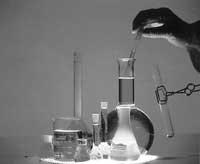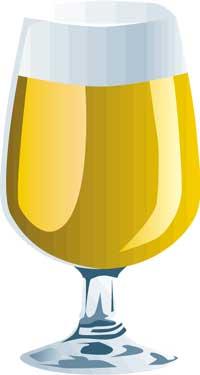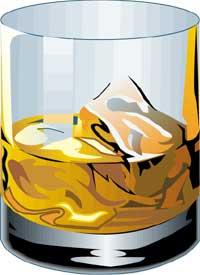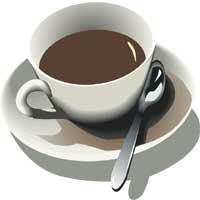Natural form of liquids

We have heard and believed that liquids have no proper shape and that they are taken from their container. But it is not a round truth. It is the spherical shape of any liquid (fluid). In most cases, due to the influence of gravity, this natural form is not perceived and therefore, when poured out of the container, they acquire the form of a sheet and when they are inside the container, that of the container itself. Within a liquid with the same density, liquids, according to the principle of Archimedes, lose their “weight” and act as if they had no weight, that is, if they were not gravitational. In these cases you can see the natural shape of the liquid, as indicated above, which is spherical.
Olive oil stays floating on the water, but if it gets into the alcohol goes directly to the bottom. Therefore, the mixture of water and alcohol allows to compare a liquid with the same density as olive oil, in which it will not float or go to the bottom. When we introduce olive oil through a syringe in this mixture, we can observe a surprising phenomenon: olive oil is collected inside forming a large spherical drop. This drop does not go down or rise, it remains like an isequite in the liquid. When performing the experiment, be careful if instead of a large drop we do not want to get a large number of spheres. The result will always be the one described.

Once this large oil sphere is achieved, we can pass through its center a wooden wedge or a wire that will act as an axis. If we turn the axis, the sphere will also begin to rotate (to bring the experiment to a good end, it is convenient to protect the part of the axis that remains inside the oil drop with an oil-impregnated board). Due to the rotation movement, the sphere begins to tread. After a few seconds a ring is released from the dial. Later, the ring is undone in several parts, but not everywhere: spheres will be formed that will also revolve around the center of the original sphere.
This experiment was first performed by the Belgian physicist Plateau. What we have described is a classic experiment, but it can also be done in a more simple and clarifying way. Take a small glass and, after drying it well, take it with olive oil, put this glass in a larger one and please fill the second glass of alcohol until the first is completely covered. Now we are prepared very carefully to pour water with a teaspoon — so that the experiment goes well, we will throw water through the walls of the big glass.

The surface of the olive oil of the small glass will gradually take shape of gymbilla. As the amount of water increases, the oil leaves the small vessel and takes the form of a grandiose sphere, which is drained in the water-alcohol mixture. In 1963, the cosmonauts Nikolaiev and Papovich, located in the spaces Vostik-3 and Vostik-4, were able to analyze in space the behavior of liquids without influence of gravity. Some of the conclusions of these investigations were really surprising. For example, they saw that the liquid in a spherical container was not stored inside it and that it did not form a sphere, as expected, that, against the “logic”, covered the liquids in the inner wall of the container and left an air pump in the center. That is, in the Plateau experiment the air played in space like oil.
Drains are round
As we have seen, when released from the influence of gravity, liquids show us their natural form, spherical. When bodies fall freely, the effect of gravity, so to speak, is “spent” during the fall and, apart from the fall itself, we can say that bodies behave freely with respect to gravity. If we discard the low friction of the air, we can think that throughout the fall the parts of a liquid will take the natural form, that is, they will have a spherical shape, and so it is. For example, when it rains we can see that raindrops are more or less spherical.
In the same line, it can be said that drains are only refrigerated cast lead drops. Once the lead is cast in the factories, it is poured from a certain height to a tank full of cold water. Lead drops thus acquire an almost spherical shape and, in contact with cold water, solidify and maintain it.
By oniles

So far we have dealt with the proper shape of liquids, while the next one will allow us to analyze another particularity of fluids through an example well known to many.
Anyone who has ever used the flap to fill a bottle knows that sometimes you have to lift the bottle so that the liquid enters the inside of the bottle, otherwise it often stays in the bottle. The reason is that the air in the bottle, due to the inability to extract from it, exerts an ascending pressure on the liquid contained in the onil. At first the liquid enters well by compressing the air in the bottle, but as the liquid enters, the air pressure increases until the fluid enters. Then we have to lift a little the onila so that the compressed air inside has outlet, so we get to bottle more liquid.
So, it is very useful that the tube of the onycle has stretch marks that allow the entrance to the bottle not to close completely and that the interior air comes out.
Forever Question
Continuing with the particularities of liquids, we wanted to bring the question that we have all heard several times: What weighs more a kilo of wood or a kilo of iron? More than one, without thinking too much, responds “the iron”, provoking, incidentally, the craving of the addict. In any case, those who wanted to get their hair would be more laughable if they answered “wood” because the answer seems absurd. But it is correct.

The reason for this rests on the principle of Archimedes. This principle is fulfilled by all fluids, i.e. liquids and gases. Thus, every body in the air suffers an ascending force whose value is equal to the volume of liquid corresponding to the place in which it is located. With this we must understand that to know what is the “weight” of the body in the air, we must remove the push from the air to its real weight.
Wood and iron suffer this push up. But since the volume of a kilo of wood is much greater than that of iron (about fifteen times), if we actually measure a kilo of iron and a kilo of wood with a weight, as the measurement has been done in the air, the actual weight of the piece of wood is greater than that of iron. There you have the answer!





